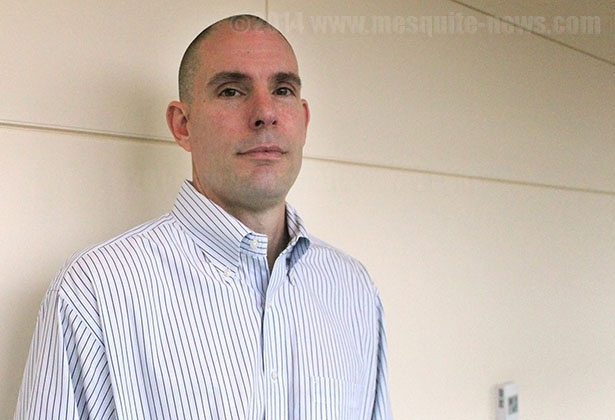
By Emily Rodriguez
Two years into a grant given to Bexar County to expand treatment and services for offenders who participate in specialty courts, the county contracted criminology Associate Professor Durant Frantzen to evaluate the court’s effect on recidivism, or rearrest rates.
The Substance Abuse and Mental Health Services Administration awarded the Bexar County Commissioners Court the grant Sept. 30, 2012 to assist in expanding treatment and services for substance abuse and behavioral health, as well as to hire additional case managers to handle larger case loads.
The administration allocated the $975,000 grant over three years, ending in 2015.
“It’s an exciting opportunity to be able to work on this project,” Frantzen said. “For me, being able to positively impact the agencies that are really close to home and establish some relationships with the agencies here is what I enjoy the most.”
The county plans to use the evaluation to determine if specialty courts are a cost-effective investment.
Specialty courts are a form of rehabilitative justice that assist offenders of certain types of offenses such as drug or alcohol. Offenders are sent to a specialty court after convicted and sentenced.
“The specialty courts are designed to handle high risk offenders. People with high risk of recidivating, high needs, that are essentially one step away from going to prison,” Frantzen said. “The idea is to rehabilitate them, get them the resources that they need so they don’t reoffend and keep them clean.”
Evaluation Plan
The evaluation will measure the rearrest rates of those who participated in the specialty courts, determine the time span it takes offenders in the program to reoffend in any arrestable offense.
“Recidivism is kind of a controversial thing. Most times people look at one-year or three-year rearrest rates following from where they were discharged from prison, probation or a (specialty) court and see if they were rearrested, that’s what I’m looking at,” Frantzen said.
The information, including demographics such as social and behavioral problems, will help determine factors that impact recidivism while in an intervention program.
The evaluation will answer five research questions:
1. How do one- and two-year recidivism rates (i.e., rearrest rates) compare for program
participants and similarly matched subjects, net of controls?
2. Do program participants recidivate less frequently than similarly matched subjects, net of controls?
3. Does program “dosage” (length of program retention) impact offender recidivism?
4. What internal process factors (demographic, case management characteristics) affect
offender retention and recidivism?
5. If a reduction in recidivism exists, what is the return-on-investment for the program?
Data Collection
To collect a sample, Frantzen uses 30 percent of the specialty court participants, enters them into a database and compares them to the control group — offenders who were eligible to participate in the program but declined.
A propensity score matching technique will compare program participants to the control group to reduce bias by removing variables that could confuse the analyzer.
The sample will collect data on the recidivism rate one and two years after the offenders graduate or drop out of the program. Information of the nature of the rearrest and any relevant social health, mental health or case management information is collected for each court’s evaluation.
Potential impact on specialty courts
Frantzen has until Sept. 29, 2015, the end of the fiscal year, to complete the evaluations of each specialty court. Upon completion, Frantzen will submit a report to the director of judicial services outlining the results.
Depending on the drop in the recidivism rate, the county will decide if the specialty courts will continue to receive extra funding. Frantzen said a 15 percent decrease in the recidivism rate would be substantial but it is up to the county to decide any further action.
“There’s a cost to enhanced services. If there’s not a cost benefit to the specialty courts then it becomes and issue of whether or not the county will continue to fund those entities beyond the date which the grant expires,” Frantzen said.
A Transactional Cost Analysis, attached to the evaluation’s conclusion, will determine if the reduction in recidivism rates was caused by an increase in staffing, services and resources.
Offenders add to the TCA by using a resource or has contact with the system such as submitting to drug testing or counseling.
Frantzen said the current rate for reoffending within a three year period is 66 percent. On a national level, literature written on specialty courts shows that the courts reduce recidivism rates.
Student intern observes impact first-hand
Christina Garcia, criminology senior and intern at the Bexar County Felony Drug Court, one of the six courts Frantzen evaluates, sees first hand the effects of speciality courts on participants.
Garcia said the drug court offers a more personalized experience for each participant; the services the drug court provides aims to keep them clean and out of jail.
“Each individual has their case manager, their probation officer and different services that they have to attend. They also have different therapy groups they have to attend, kind of like (Alcoholics Anonymous),” she said. “They’re hit from every side trying to get them help.”
Although Garcia is only present for a limited amount of time throughout the drug court process, she observed each participant’s journey through the court and their efforts to stay clean.
“When I came into this I could already see people who are really, really, trying and they have that desire to be different. They have that desire to please the judge and to please the drug court and their case managers. They’re getting their inspiration from the drug court,” she said.
If recidivism rates are not high enough to justify the extra funding given to the specialty courts, the services they provide will feel the effects.
“The funding that they get still isn’t enough to support them,” Garcia said. “For instance, someone needs to get some kind of medication to help cope with the cravings. Those things are expensive without insurance or Medicare or Medicaid, the drug court has to foot the bill. It will really cripple them and hurt them in the long run trying to reach out to these people and help them overcome these issues.”






